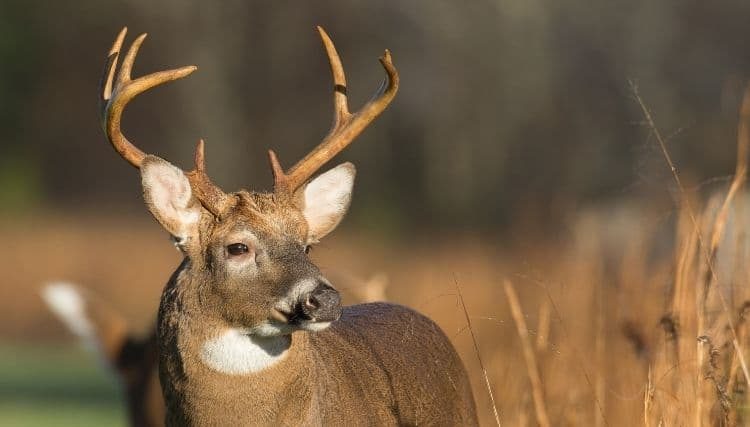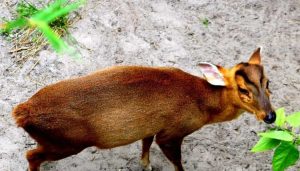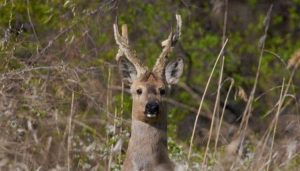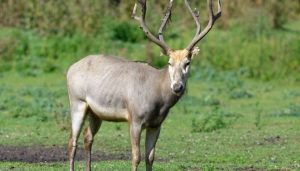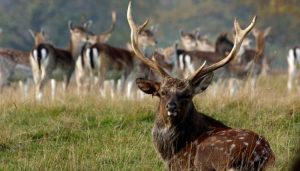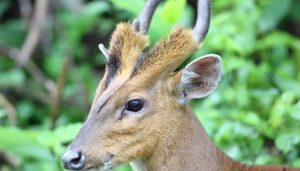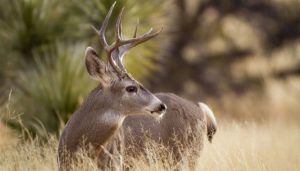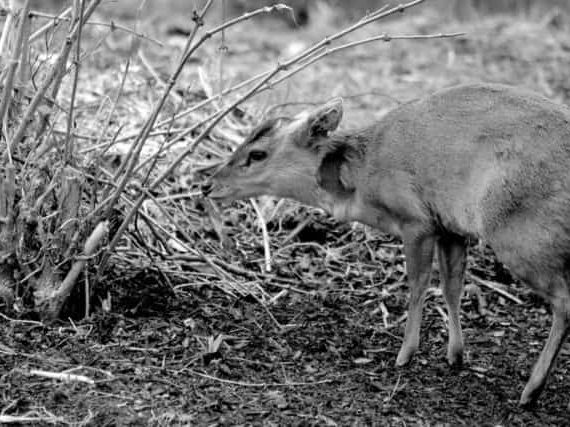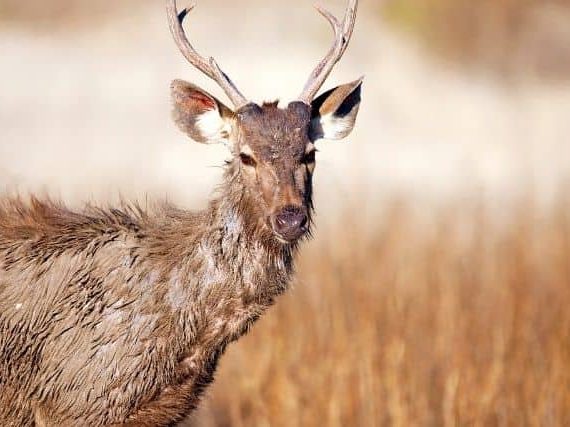If you’ve ever wanted to know all there is to know about white-tailed deer, then this guide is for you.
What Are White-Tailed Deer?
White-tailed deer are a species of deer native to North and Central America. They are known for their distinctive white tail, which they raise and flash as a warning signal. White-tailed deer have reddish-brown coats in the summer that turn grayish-brown in the winter.
They are herbivorous animals, primarily feeding on leaves, twigs, fruits, and grasses. White-tailed deer are highly adaptable and can be found in a variety of habitats, including forests, fields, and suburban areas. They are also popular game animals for hunting.
What is White-Tailed Deer Size?
White-tailed deer typically have a body length ranging from 5 to 6.5 feet (1.5 to 2 meters). They stand about 3 to 3.5 feet (0.9 to 1.1 meters) tall at the shoulder. The weight of an adult white-tailed deer can vary depending on factors such as age, sex, and available food resources. On average, adult males, called bucks, weigh between 150 and 300 pounds (68 to 136 kilograms). Adult females, known as does, are generally smaller and weigh between 90 and 200 pounds (41 to 91 kilograms).
Habitat For WhiteTtailed Deer
White-tailed deer are adaptable animals that inhabit a range of habitats across North and Central America. They can be found in diverse environments, including forests, woodlands, swamps, grasslands, brushy areas, and even suburban neighborhoods.
In forested regions, white-tailed deer thrive in a variety of forest types, such as deciduous forests, mixed forests, and coniferous forests. They utilize the understory vegetation for foraging and seek cover and protection in forested areas.
Fields and meadows with abundant grasses and herbaceous plants are also preferred habitats for white-tailed deer. These open areas provide ample grazing opportunities and can be found near forested regions or in agricultural landscapes.
White-tailed deer are also known to inhabit wetland areas, including marshes, swamps, and riparian zones. These habitats provide a mix of vegetation, water sources, and cover, making them suitable for deer.
In more urbanized areas, white-tailed deer have adapted to living in suburban and even urban environments. They can be seen in parks, golf courses, and green spaces within cities where food and cover are available.
Overall, white-tailed deer have a remarkable ability to adapt to various habitats, as long as they have access to suitable food sources, cover, and water.
What is The Physical Description Of White-Tailed Deer?
White-tailed deer have distinct physical features that are characteristic of their species. Here is a brief description of their physical appearance:
Size: Adult white-tailed deer typically have a body length ranging from 5 to 6.5 feet (1.5 to 2 meters). They stand about 3 to 3.5 feet (0.9 to 1.1 meters) tall at the shoulder.
Coat: White-tailed deer have a reddish-brown coat during the summer, which helps them blend into their surroundings. In the winter, their coat turns grayish-brown, providing camouflage in snowy environments. The underside of their tail is white, and they have a small white patch on their throat.
Antlers: Only male white-tailed deer, known as bucks, grow antlers. Antlers are bony structures that are shed and regrown each year. The size and shape of antlers vary depending on factors such as age and genetics. They are typically branched and can have multiple points or tines.
Ears: White-tailed deer have large, erect ears that rotate independently, allowing them to detect sounds from various directions. The inside of their ears is lined with white hair.
Tail: One of the most distinguishing features of white-tailed deer is their long, fluffy white tail. When alarmed, they raise their tail and flash them as a warning signal to other deer.
Body Shape: White-tailed deer have slender and athletic bodies with a narrow waists. Their legs are long and slender, enabling them to run quickly and jump over obstacles.
Overall, white-tailed deer have a graceful and elegant appearance, well-suited for their agility and survival in various habitats.
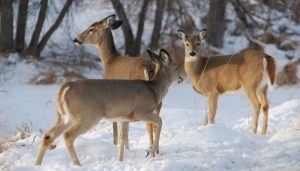
White-Tailed Deer Mating Season
Reproduction -Breeding
White-tailed deer have a specific breeding season, commonly referred to as the rut. The timing of the rut can vary depending on geographic location, but it generally occurs in the fall, typically from October to December.
During the rut, male white-tailed deer, or bucks, compete for dominance and mating opportunities. They engage in various behaviors to establish their dominance, including vocalizations, antler displays, and physical confrontations with other bucks.
Female white-tailed deer, known as does, come into estrus or “heat” for a brief period, usually lasting about 24 to 48 hours. During this time, they are receptive to mating. Does release pheromones and vocalizes to attract bucks.
Once a buck finds a receptive doe, he will engage in courtship behavior, which may involve following the doe, displaying his antlers, and engaging in a series of ritualized behaviors. If the doe is receptive, mating will occur.
After mating, a doe has a gestation period of around 200 to 205 days or approximately 6 to 7 months. Does typically give birth to one to three fawns, although twins are most common. Fawns are born in the spring or early summer.
The fawns are initially small and spotted, providing camouflage. They rely on their mother’s milk for nourishment during their early weeks. As they grow, they start to consume vegetation and transition to a diet similar to adult white-tailed deer.
It’s important to note that while white-tailed deer typically follow this breeding pattern, variations can occur based on factors such as population density, habitat conditions, and individual deer behavior.
How Long Does A White-Tailed Deer Live?
The lifespan of a white-tailed deer can vary depending on several factors, including habitat quality, predation, hunting pressure, and availability of food and water. In general, white-tailed deer have an average lifespan of 6 to 14 years in the wild. However, it’s important to note that many deer do not reach their maximum potential lifespan due to natural mortality factors and human-related activities.
Environmental conditions and predation play a significant role in the survival of white-tailed deer. Harsh winters, limited food availability, diseases, and predation by predators such as wolves, coyotes, bears, and mountain lions can impact deer survival rates and reduce their overall lifespan.
In areas with controlled hunting, deer populations are managed to maintain a balance between their numbers and available resources. Hunting can help regulate population size and reduce competition for resources, leading to healthier individuals and potentially longer lifespans for some deer.
It’s worth mentioning that captive white-tailed deer, such as those in zoos or game farms, may have longer lifespans due to the absence of predation, controlled diet, and veterinary care. In captivity, they can live up to 20 years or more.
Overall, the lifespan of a white-tailed deer is influenced by a combination of natural factors and human activities, making it variable and dependent on specific circumstances.
Virgin Deer Communication And Perception
White-tailed deer, including virgin deer (those that have not yet mated), use various forms of communication and have acute senses to navigate their environment. Here are some aspects of their communication and perception:
-
Vocalizations: White-tailed deer produce a range of vocalizations, including grunts, bleats, snorts, and wheezes. These vocalizations serve different purposes, such as attracting mates, expressing distress or alarm, or maintaining contact with fawns.
-
Scent Communication: Scent plays a crucial role in communication among white-tailed deer. They possess scent glands located on their lower legs, forehead, and around their eyes. These glands produce pheromones, which are chemical signals used for marking territories, signaling reproductive status, and conveying social information.
-
Body Language: White-tailed deer rely on body language to communicate with each other. They use various postures, movements, and gestures, such as raising their tail, flattening their ears, or stomping their hooves, to convey different messages, including aggression, submission, or alarm.
-
Visual Perception: White-tailed deer have well-developed eyesight and can detect movement and distinguish colors. They have a wide field of view due to the positioning of their eyes on the sides of their head, which allows them to have a nearly 310-degree panoramic view. This aids in detecting potential threats and predators.
-
Hearing: White-tailed deer have highly sensitive ears that can rotate independently to pinpoint the source of sounds. They have excellent hearing, capable of detecting high-frequency sounds, including the rustling of leaves or the vocalizations of other deer.
These communication and perception abilities help virgin deer in various ways, such as locating food, detecting predators, maintaining social bonds, and participating in reproductive activities. By utilizing vocalizations, scents, body language, vision, and hearing, they navigate their environment and interact with other deer effectively.
What Do White-Tailed Deer Eat?
White-tailed deer are herbivorous animals and have a diverse diet that varies depending on the season and the availability of food resources. Their diet primarily consists of the following:
-
Plants: White-tailed deer consume a variety of plants, including leaves, twigs, shoots, and buds. They browse a wide range of herbaceous plants, shrubs, and tree species. In the summer, they feed on grasses, legumes, and forbs. In the winter, when green vegetation is scarce, they rely more on woody browse, such as the leaves and twigs of shrubs and young trees.
-
Fruits and Nuts: White-tailed deer also consume fruits and nuts when available. They eat a variety of fruits, including berries, apples, grapes, and persimmons. Acorns, beech nuts, and other mast crops are important food sources for deer, particularly in the fall.
-
Agricultural Crops: In some areas, white-tailed deer may feed on crops, such as corn, soybeans, wheat, alfalfa, and clover. Their presence in agricultural landscapes can sometimes lead to conflicts with farmers.
-
Mushrooms and Fungi: White-tailed deer are known to consume mushrooms and various types of fungi, especially during the rainy season when mushrooms are abundant.
The specific composition of their diet can vary based on geographical location, habitat type, and seasonal availability of food resources. White-tailed deer are adaptable browsers and can adjust their feeding habits to the resources present in their environment.
What is The virgin Deer’s Role İn The Ecosystem?
In the context of white-tailed deer, the term “virgin deer” typically refers to a deer that has not yet mated or reproduced. While individual virgin deer do not have a specific role in the ecosystem beyond their general participation as members of the species, white-tailed deer as a whole play important ecological roles in their respective habitats. Here are some key contributions of white-tailed deer to ecosystems:
Herbivory: White-tailed deer are significant herbivores and play a crucial role in shaping vegetation dynamics. By browsing on plants, they can impact plant growth, density, and species composition, which, in turn, affects the overall structure and biodiversity of plant communities.
Seed Dispersal: White-tailed deer aid in seed dispersal through their consumption of fruits and nuts. Seeds that pass through their digestive system can be dispersed to different areas, potentially facilitating plant regeneration and colonization in new locations.
Habitat Modification: Deer activity, such as foraging and movement, can influence habitat structure and create openings or disturbances within ecosystems. These alterations can benefit certain plant and animal species that thrive in early successional habitats.
Prey-Predator Dynamics: White-tailed deer are prey species for several predators, including wolves, coyotes, bears, and large cats. Their presence and population dynamics contribute to the food web and support predator populations.
Cultural and Economic Significance: White-tailed deer hold cultural and economic value. They are important game animals for hunting, which contributes to local economies and cultural practices.
Virgin Deer Conservation Status

Virgin Deer Conservation Status
The conservation status of white-tailed deer, the species to which virgin deer belong, varies depending on the specific region and population. Overall, white-tailed deer (Odocoileus virginianus) are not currently considered globally threatened or endangered. They are one of the most abundant and widely distributed deer species in North and Central America.
However, it’s important to note that localized populations of white-tailed deer can face conservation challenges due to factors such as habitat loss, habitat fragmentation, hunting pressure, and conflicts with human activities. In some areas, high deer densities can have negative impacts on ecosystems, leading to overbrowsing, damage to vegetation, and other ecological imbalances.
Conservation efforts for white-tailed deer often focus on maintaining healthy and sustainable populations through habitat management, hunting regulations, and wildlife management practices. These efforts aim to balance deer populations with available resources and mitigate conflicts between deer and human activities.
In summary, while “virgin deer” does not have a specific conservation status, white-tailed deer as a species are not globally endangered but may require local conservation measures to address specific population and habitat challenges.
How Many White-Tailed Deers Have Left İn The World?
It is challenging to provide an exact global population estimate for white-tailed deer (Odocoileus virginianus) due to their wide distribution across North and Central America and variations in population densities within different regions. Additionally, population sizes can fluctuate over time due to factors such as habitat conditions, predation, hunting, and management practices.
White-tailed deer are considered one of the most abundant deer species in the Americas, and their populations are generally stable or increasing in many areas. In the United States alone, which has the largest white-tailed deer population, estimates suggest there are approximately 30 to 40 million individuals.
In Canada, Mexico, and Central America, white-tailed deer populations also exist, but their numbers vary by region and are generally lower than in the United States. In Mexico, for example, white-tailed deer populations have been estimated to range from several hundred thousand to a few million individuals.
Considering these regional estimates and the absence of a comprehensive global population survey, it is difficult to provide an accurate worldwide count of white-tailed deer. However, their abundance and adaptability across their range indicate that they are not currently facing a significant global population decline or threat of extinction.
How Fast Can A White-Tailed Deer Run?
White-tailed deer are known for their impressive speed and agility. They are excellent runners and can reach impressive speeds when they need to escape from predators or other threats. On average, a white-tailed deer can run at speeds of up to 40 to 45 miles per hour (64 to 72 kilometers per hour) in short bursts.
Their quick acceleration allows them to swiftly navigate through dense vegetation or over rough terrain. However, white-tailed deer cannot sustain their top speed for long distances. They typically rely on their agility and ability to change direction quickly to evade predators rather than engaging in prolonged sprints.
- Facts About Sika Deer: Everything You Wanted to Know
- Referans: White-Tailed Deer
- Odocoileus virginianus
- White-tailed Deer Wildlife Note
What is the common name for the white-tailed deer?
A common name for white-tailed deer is white-tailed deer.
Why are white-tailed deer bad?
White-tailed deer are destructive to the environment. They destroy native plants and eat seeds and fruit, which may be needed for new plants to grow. Plus, they are a threat to humans because they can cause car collisions when they crossroads.
What states do white-tailed deer live in?
White-tailed deer are found in North America, and they live across the continent. They can be seen in all 50 states, although they are most concentrated in the Southeastern part of the United States.
Where do most white-tailed deer live?
White-tailed deer are among the most populous members of the deer family. There are estimated to be around 30 million white-tailed deer in North America alone.
Where do white-tailed deer sleep?
White-tailed deer usually live in woodlands and forests during the daytime and come out to graze at night. They prefer to spend their days asleep in a spot that offers tree cover, which is why they often sleep under trees or near bushes. White-tailed deer also sleep under fallen logs or other debris that can provide shelter and protection from predators such as bears.
What plants do white-tailed deer avoid?
Plants that white-tailed deer tend to avoid:
Asters,
Balsam,
Blueberries,
Burdock,
Caffeine plants, such as coffee and tea trees
Can white-tailed deer swim?
White-tailed deer are not exactly water-loving creatures. They mostly prefer to stay out of the water. However, they can swim if they need to cross a body of water that would be too large for them to jump over or swim across.
Are is white-tailed deer aggressive?
White-tailed deer are not aggressive, usually. However, they may be more likely to attack if they feel threatened.
White-tailed deer have a calm and docile behavior when it comes to humans. They are one of the most popular species for hunting in North America, but they can become aggressive during mating season.

